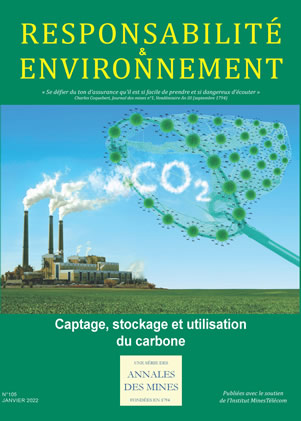|
 N° 105 - Janvier 2022 - Captage, stockage et utilisation du carbone N° 105 - Janvier 2022 - Captage, stockage et utilisation du carbone
The development of UK CCUS strategy and current plans for large-scale deployment of this technology
By Jon GIBBINS
UK CCS Research Centre, University of Sheffi eld
And
Mathieu LUCQUIAUD
University of Edinburgh
For over 20 years, carbon capture utilisation and storage (CCUS) has been recognised as a useful tool to help reduce UK national emissions. Over this period the target reduction in greenhouse gas emission rates for 2050 has increased, from 60% to 100%, i.e. net zero. This has led to change in the role envisaged for CCUS, from initially just cutting emissions on coal power plants by around 50%, to the point where capture and secure sequestration of all fossil CO2 emissions is required, either directly at source or indirectly via carbon dioxide removal from the air (CDR). Additional CDR, either through the use of biomass energy with carbon capture and storage (BECCS) or direct air carbon capture and storage (DACCS), will also be required to compensate for other UK greenhouse gas emissions. Potentially over 100 MtCO2/yr of CCUS is needed by 2050. Current UK plans are to establish four CCUS clusters by 2030, capturing and storing a minimum of 10 MtCO2/yr from industry, power, hydrogen production and, potentially, CDR. The UK has a large amount of secure storage capacity for CO2 in geological formations a kilometre or more below the sea bed in the North Sea and the Irish Sea.
 Télécharger gratuitement l'article Télécharger gratuitement l'article
 Retour au sommaire Retour au sommaire
 N° 105 - January 2022 - Carbon capture, storage and use N° 105 - January 2022 - Carbon capture, storage and use
The development of UK CCUS strategy and current plans for large-scale deployment of this technology
Jon Gibbins,
UK CCS Research Centre, University of Sheffield,
and
Mathieu Lucquiaud,
University of Edinburgh
For over 20 years, carbon capture utilisation and storage (CCUS) has been recognised as a useful tool to help reduce UK national emissions. Over this period the target reduction in greenhouse gas emission rates for 2050 has increased, from 60% to 100%, i.e. net zero. This has led to change in the role envisaged for CCUS, from initially just cutting emissions on coal power plants by around 50%, to the point where capture and secure sequestration of all fossil CO2 emissions is required, either directly at source or indirectly via carbon dioxide removal from the air (CDR). Additional CDR, either through the use of biomass energy with carbon capture and storage (BECCS) or direct air carbon capture and storage (DACCS), will also be required to compensate for other UK greenhouse gas emissions. Potentially over 100 MtCO2/yr of CCUS is needed by 2050. Current UK plans are to establish four CCUS clusters by 2030, capturing and storing a minimum of 10 MtCO2/yr from industry, power, hydrogen production and, potentially, CDR. The UK has a large amount of secure storage capacity for CO2 in geological formations a kilometre or more below the sea bed in the North Sea and the Irish Sea.
 Retour au sommaire Retour au sommaire
|




